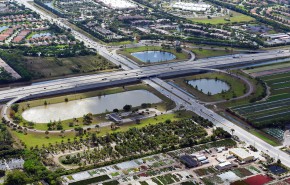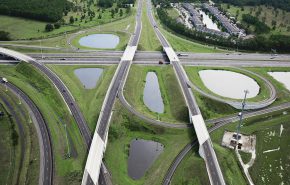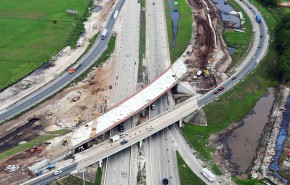GAI Vice President Stephen Boylan, PE discusses managed lanes and other highway design trends helping to alleviate congestion on heavily traveled roadways.
Q: What are some of the client key goals you’re seeing in recent projects and emerging ways to meet those goals?
Steve Boylan: Goals are pretty varied, but throughout the state of Florida and elsewhere clients are just constantly trying to catch up with the overflow of traffic. To address this, we’re seeing more and more calls for alternative systems for limited-access roadways.
A good example that we’re seeing downtown Orlando and elsewhere in the state is managed lanes—often called express lanes. These are designated lanes that charge users a sliding toll—the idea is to give drivers an alternative that will ease congestion and get them to their destination quicker.
Transportation Projects Optimize Traffic Flow
GAI provided line and grade design for a diverging diamond interchange at the Sand Lake Road/I-4 Interchange in Orange County, FL—the first project of its kind in Central Florida.
![]()
I-4 and Florida’s Turnpike Mainline Design-Build
The centerpiece of this project is the design and construction of a direct-connect flyover ramp between the I-4 Ultimate and Turnpike Express Lane systems.
![]()
I-95 Express Lanes Design Build
This critical component of South Florida’s Express Lanes Network will complete the I-95 Express Lanes system in the area by adding two managed lanes in each direction.
![]()
SR 589, Veterans Expressway, Section 5, Widening Design-Build
This project implemented all-electronic tolling and completed a 20-mile, 5-section managed lanes system.
Managed lanes are in use quite a bit in south Florida already—they’re being built in the middle of Orlando as we speak, and new projects that include managed lanes are about to start in northeast Florida in the Jacksonville area. There they’ll have the same general-purpose lanes as previously—like a six-lane interstate, for instance—and will add two more lanes in each direction. The result will be a 10-lane road and two of those lanes will charge a flexible toll, so you always have moving traffic.
The goal is to never have traffic in the managed lanes moving below 40 miles per hour. The tolls to use the managed lanes rise during peak usage like rush hours, and in the middle of the night managed lane tolls go down to almost nothing.
The most important thing is, managed lanes really work. Recently I was driving on the Palmetto Expressway down in south Florida, and traffic was backed up nose-to-tail. I had to get where I was going by a certain time so I switched over to the managed lane, and zipped along parallel to all that traffic at 70 MPH. So, I can speak from experience that managed lanes do the job they are intended to do. It’s great for offering drivers an option while cutting down on congestion in the general lanes.
Q: Sounds like the managed lanes really work—are clients calling for these more often as they are proving successful?
Steve: Managed lanes and highway widening have become very, very popular in Florida over the last couple of years. These solutions were born out of Dade and Broward Counties—areas that often experience extreme traffic congestion conditions—and now I’m seeing them being considered for all parts of Florida. Managed lanes are under consideration for a stretch of Interstate 75 near Gainesville, which is a popular area but by no means on the same level of Orlando or Miami or Jacksonville—so you can see that the approach is definitely gaining traction.
Q: What other trends in congestion-minimizing designs are you seeing?
Steve: Diverging diamond interchanges offer real advantages for better traffic flow and they are gaining popularity around the country. They became a popular design in the central part of the country—especially in Missouri and Kansas—and more recently have made their way to Florida. (See: Diverging Diamond Interchange—Going Against Expectations)
A group of engineers and designers who are now at GAI along with myself worked on the first diverging diamond interchange on Florida’s east coast in Melbourne. And now, diverging diamond interchanges have become a required design alternative in the planning stages of major grade-separated interchange projects in Florida—right up there with traditional alternatives like standard diamond and signal-point interchanges. So, they will be coming into use more and more, and I’m glad my teammates and I are prepared with a proven record of successfully deploying these designs.
Q: How do diverging diamond interchanges work?
Steve: Alleviating congestion in an interchange is all about trying to maintain traffic flow—and as you can probably guess, the movement that most interrupts that flow is when vehicles make a left turn across traffic.
When entering a diverging diamond interchange, traffic in both directions is crossed to the left side of the road, so that left turn is essentially taken offline and turned into a continuous motion. Traffic crosses back to the right side of the road at the far end of the diverging diamond interchange, and vehicles making a right turn do so at that point, again in a smooth, continuous movement. With some exceptions, the only required traffic signals are generally positioned well before vehicles enter the diverging diamond interchange itself.
Q: What are some of the key ways to add value for clients when performing these types of projects?
Steve: In this industry, it’s difficult to earn a reputation for having tremendous quality and tremendous service at all times, it’s very hard. And the companies that have succeeded and continue to succeed have figured out how to do that.
It’s a careful balance—it means you have to have a talented design team, bring the right people to the job without over staffing, and assign experienced project managers who are committed to meeting project budget and deadlines.
And that’s one of the things that defines GAI: the company is very much in tune with what our primary clients are looking for. Beyond developing great, trusted relationships with clients, we’ve got a wonderful cadre of Professional Engineers, designers, production staff, and technicians to continually reinforce that trust. The team works together seamlessly to deliver a great product—and whether it’s managed lanes, diverging diamond interchanges, or any other transportation initiative, a superior and successful end result that meets both budget and specs is the best value we as a company can offer any client.
Contact Steve Boylan, PE, 321.319.3071, for more information about diverging diamond interchanges and GAI’s transportation engineering services.
![]() Stephen Boylan, PE has extensive experience in design and project management, specializing in the design of major limited access and arterial roadway reconstruction, roadway rehabilitation, and elements of traffic design.
Stephen Boylan, PE has extensive experience in design and project management, specializing in the design of major limited access and arterial roadway reconstruction, roadway rehabilitation, and elements of traffic design.


